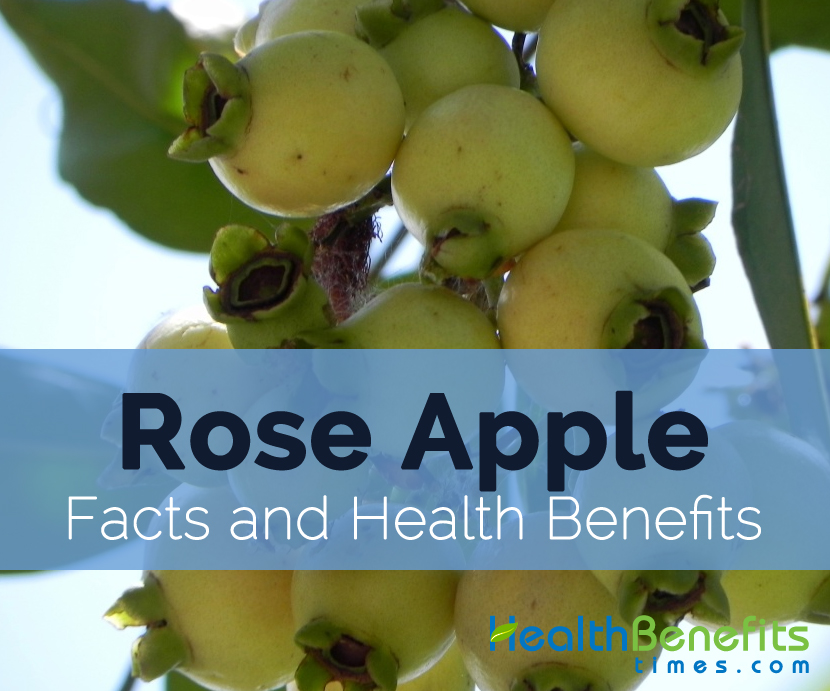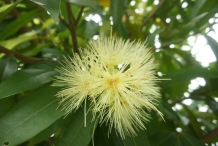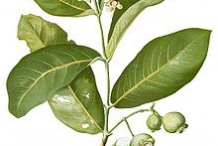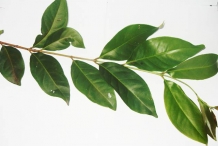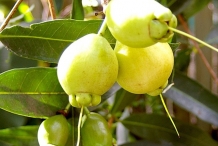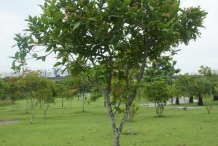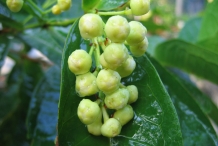| Watery Rose Apple Quick Facts |
| Name: |
Watery Rose Apple |
| Scientific Name: |
Syzygium aqueum |
| Origin |
East Indies and Malaya, also cultivated in Ceylon, the Pacific Islands, India and former Indochina |
| Colors |
White, Pink-red |
| Shapes |
Bell-shaped, Length: 5–8 cm |
| Flesh colors |
White, Creamy |
| Taste |
Mild sweet |
| Calories |
25 Kcal Kcal./cup |
| Major nutrients |
Vitamin C (24.78%)
Vitamin B3 (5.00%)
Carbohydrate(4.38%)
Dietary Fiber (3.95%)
Calcium (2.90%) |
| Health benefits |
Prevent Diabetes, Prevent Constipation, Prevent muscle cramps, Skin Health, Eliminate free radicals |
| More facts about Watery Rose Apple |
Watery Rose Apple with its scientific name Syzygium aqueum, is an tropical, evergreen and low growing small tree. Botanically, it belongs to the Myrtaceae family and genus Syzygium. It is also called Water Apple and Bell Fruit. The Rose Apple has different names in various languages such as French: Jambosier D’eau, Pomme D’eau; Japanese: Mizu Renbu; Spanish: Manzana De Agua, Perita Costena; Thai: Machomphu-Pa, Chom Pu Pa and Malaysia: Jambu Chili, Jambu Ayer. Water Rose Apple, Malay Rose Apple, Jambu and Java Rose Apple are the four different types of Rose Apple which are grown all over the world.
Historical reports suggest that the plant was originally indigenous to the Southeast Asian region, most probably the current country of Java, but with time, through the activity of traders, was distributed to other parts of the world. Today, the plant is cultivated in most of the tropical countries, including the Indian subcontinent and the sub-Saharan African regions (Benin, Democratic Republic of Congo, and Cameroon), as well as in South America and the warmer parts of America.
History
Probably it was originated to the East Indies and Malaya. Besides the inherent countries, it is also cultivated in Ceylon, India, Pacific Islands and Indochina.
Plant
The Watery rose apple tree grows to a height of 6 m to 15 m, and has a grayish-brown bark. The leaves are thin, narrowly lanceolate, coriaceous, spanning a length of 10 cm to 23 cm and a width of 2.5 cm to 5 cm, with along acuminate apex, cuneate base, and petioles measuring 0.5 to 1 cm in length. The flowers are terminal with single-branched cymes of about 2 cm in length. A funnel form of hypanthium, measuring about 7 to 10 mm in length, is seen to narrow into a short pseudoterminal of 3 to 4 mm length. Two pairs of fleshy, unequal, persistent, glabrous or sparsely puberulent sepals are present, one pair measuring about 6 to 8 mm in length and the other 4 to 6 mm. Four orbicular to ovate-orbicular concave petals with a white to greenish-white coloration are present (12 to 20 mm in length), along with long creamy white filaments (10 to 50 mm long). The tree bears whitish- to pinkish-yellow sub globose berries with a fleshy pericarp (10 to 15 mm thick). Usually, a single sub globose seed is present, having a diameter of 2 to 2.5 cm and bearing testa closely coherent to the cotyledons.
Fruit
The tree bears fruit from early winter to the late fall. The fruit is bell-shaped, about 5 to 8 cm long. The fruit is pink to red in color with white texture flesh. The color of the flesh differs in the type of cultivar grown. The fruits which are ripened have light and faintly aroma with moderate sweet taste. Each fruit possess one or two grey seeds. The fruit has got smooth and thin skin.
Nutritional value
Watery Rose Apple possess rich amount of iron, calcium, fiber, Vitamin C, protein and Vitamin A. 100 gm of Rose Apple contains calcium (29 mg), potassium (123 mg), sulphur (13 mg). The same amount of Rose Apple provides Vitamin C (24.78%), Total fat (0.86%), Iron (0.88%) and Phosphorus (1.14%).
Health Benefits of Watery Rose Apple
1. Fights Free Radical Damage
Watery Rose Apple is rich in Vitamin C which prevents the damage of free radicals, pollutants and toxic chemicals which leads to the health ailments such as heart disease, cancer and arthritis. Free radicals are developed in the body when the body is exposed to the radiation, tobacco or smoke and during the process of breaking down of food.
Vitamin C enhances the white blood cells production and also assists in the functioning. As Vitamin C is an antioxidant, it eliminates the oxidative damage and enhances the smooth functioning. It is also believed that Vitamin C effectively boosts the immune system to counteract the colds.
2. Reduced Risk of Stroke
The presence of Vitamin C in the Watery Rose Apple lowers the chances of stroke and health ailments such as inflammation, oxidative damage, cardiac health, atherosclerosis, blood pressure and endothelial health. The research summarizes that the development of plaque in the body results in the stroke or heart attack which could be reduced with the Vitamin C. 22 mg of Vitamin C is obtained from 100 grams of Rose Apple.
3. Boost good HDL Cholesterol
Watery Rose Apple is the source of Niacin which is used to add cholesterol. The studies shows that Niacin enhances the HDL cholesterol levels and reduces the triglycerides and LDL cholesterol.
4. Prevent Diabetes
The research has shown that the use of Watery Rose Apple reduces the level of blood glucose by enhancing the activities of carbohydrate metabolic enzymes such as glucose-6-phosphate dehydrogenase, hexokinase and glucose-6-phosphatase.(1)
5. Prevent Constipation
Dietary fiber in Watery Rose Apple supports the digestive system in the material movement and stimulate stool which is helpful for those having the irregular stools or constipation. It supports in healthy weight and reduces the chances of heart disease and diabetes.
6. Prevent muscle cramping
Watery Rose Apple also possess adequate amount of potassium which enhances the strength of muscles and reduces the muscle cramps which is lead due to the low level of potassium.
7. Skin Health
An adequate amount of Vitamin A and C could be obtained from the Watery Rose Apple which helps to prevent the damage from the oxidative stress caused from the poor diet, stress and pollution. It also reduces the dryness of the skin and reduces the wrinkles.
8. Antimicrobial Activity
Pre clinical studies have shown that an extract prepared from the bark of the Watery Rose Apple was effective against Staphylococcus aureus, Yersinia enterocolitica, Staphylo coccus hominis, Staphylococcus cohnii, and Staphylococ cus warneri. A phytochemical correlation suggests that the observed effect is due to the presence of increased amounts of tannin. An extract prepared from the leaves is also reported to be useful against A. faecalis, A. hydrophilia, B. cereus, and S. aureus.
Studies have also shown that the phytochemicals friedelin, beta-amyrin acetate, betulinic acid, and lupeol, isolated from bark, are effective against the dermato phytes Microsporum audouinii, Trichophyton mentagro phytes, and Trichophyton soudanense. The ethanolic extracts of the leaf were also observed to be effective against Mycobacterium smegmatis. Additionally, the leaf extracts showed potent antiviral effects against herpes simplex virus types I and II and on the virus involved in vesicular somatitis. Recent studies have also shown that the leaf extract possesses potent antibacterial effects against Propionibacterium acnes, the organism responsible for acne.
9. Anti-inflammatory Activity
Chronic or recurrent inflammation in the tissues results in oxidative stress, and this may play a contributory role in the initiation and/or progression and promoting of cancer cell growth. Regular administration of non-steroidal anti-inflammatory drugs (NSAIDs) reduces the risks of certain cancers, thereby asserting the fact that modulation of cellular signaling involving chronic inflammatory response by anti-inflammatory agents offers an important strategy in molecular target-based chemoprevention and cytoprotection. However, long-term administrations of NSAIDs can cause ulcerations on the gastrointestinal tract, which may become a major clinical problem.
10. Analgesic Activity
Pain is defined as an unpleasant sensory and emotional experience associated with actual or potential tissue damage, or described in terms of such damage. The sensation can be characterized as a multi-dimensional experience in which several components are involved: motivational, emotional, sensory-discriminative, affective, and cognitive. The analgesic drugs currently in use are either narcotics or non- narcotics, and have proven side effects and toxic effects. There is a need, therefore, for non-toxic agents that are safe and preferably of dietary origin. Avila-Peña et al. evaluated the analgesic potential of the hydro- alcoholic extract of the leaf of rose apple, using the standard hot plate and formalin tests, in rats. Additionally, the observed analgesic effect was enhanced by naloxone, suggesting a possible additive effect.
Health Benefits of Watery Rose Apple Plant
1. Antioxidant Benefits
An antioxidant restricts the molecules oxidation which damages the cells because of the production of free radicals which could be eliminated with Selenium, vitamin C, Lycopene, Beta Carotene, Vitamin E, Zeaxanthin and Lutein. Free radicals are the cause of various ailments such as Cataracts, Alzheimer’s disease, Cancer, Parkinson’s disease, diabetes, heart disease and cancer.
a. The leaves of Watery Rose Apple plant possess hepatoprotective and antioxidant properties. The examination on the leaves for the antioxidant properties shows that it possesses the hepaprotective activity which is comparable to the silymarin drug. (2)
b. The report which was published by American Journal of BioScience summarizes that the barks of Roseapple assist to prohibit the free radicals. As a result, this plant could be studied due to its potential of bioactivity for discovering the efficacy of its use as a medicine. (3)
2. Prevent Acne
Acne vulgaris is a skin condition which leads to the inflammation caused due to the skin infection. The research shows that the leaves of Rose Apple possess the anti-acne properties such as anti-inflammatory, antioxidant and antibacterial properties. The experiment also shows that the presence synergic actions results the antioxidant, antibacterial and anti-inflammatory activities. Thus, S. jambos assist in the anti-acne activities. This study helps to know about the herbal medicines whereas various clinical trials are being continued. (4)
3. Cure Leaver Damage
Liver damage leads to the various liver diseases which are caused due to the excessive consumption of alcohol, anemia, malnutrition, infection and hepatotoxic drugs. The research which was conducted by Gujarat Ayurved University shows that the leaves extract of Watery Rose Apple contains the liver protective agent. It leads to the efficacy in the change in function of liver than the disease control group. The efficacy was worthy of comparison to the standard drug. (5)
Traditional usage
Bark
The decoction made from astringent bark is used in folkloric medicine of Malaysia to treat thrush.
Fruit
It is served as salad at the childbirth ceremony. In India, the fruit is also used as a tonic to enhance the liver and brain.
Flower
The fever could be lessened from the sweetened prepared from the flowers.
Leaf
The decoction made from the leaves acts as an expectorant and diuretic which treats rheumatism and also cures the sore eyes.
Seeds
The health conditions such as dysentery, catarrh and diarrhea could be treated with the use of seeds. The people of Nicaragua use the infusion of roasted and powdered seeds to treat diabetes. The Colombia people believe that the seeds possess the pain killer properties.
Root
The root is used by the people of Cuban to treat epilepsy.
Medicinal uses
- Root bark and fruit are used in Chinese system of traditional medicine as a blood coolant.
- Fruit peel strengthens spleen, warm stomach and treat deep ulcers and tumors.
- Fruit is used as a tonic for brain and liver.
- Flowers have antipyretic effects and seeds treat dysentery, diarrhea and catarrh.
- Bark is used to treat asthma, hoarseness and bronchitis.
How to eat
Watery Rose Apple could be consumed raw or preserved in the form of jellies and jams. It is also added in the desserts. It is also used to make the fruit sauce or syrup.
Precautions
Watery Rose Apple possess the risk of toxicity. The seeds and roots are poisonous. The leaves, roots and stems of the plant contain the mysterious amount of cyanide or prussic acid or hydrocyanic acid which is could be harmful.
Watery Rose apple Facts
| Name |
Watery Rose Apple |
| Scientific Name |
Syzygium aqueum |
| Native |
East Indies and Malaya, also cultivated in Ceylon, the Pacific Islands, India and former Indochina. |
| Common/English Name |
Bell Fruit, Watery Rose Apple, Water Cherry, Bell Apple, Water Apple |
| Name in Other Languages |
Brazil: Jambeiro Aguado, Jambo
Portuguese: D’agua
Chinese: Shui Lian Wu;
Dominican Republic (Spanish): Cajuilito Solimán;
Dutch: Djamboe Aer;
French: Jambosier D’eau, Pomme D’eau;
German: Wasserjambuse, Wachsjambuse;
Indonesia:
Aceh: Jambi Raya, Jambi Iye;
Bali: Jambu Er, Njamu Er;
Batak: Jambu Erang, Jambu Aek,
Besemah: Jambu Ayik
Bimba: Jambu Jene,
Bugis: Jambu Saiom, Jambu Salo;
Boeol, Sulawesi, Manado: Takaw;
Ceram, Moluccas, Ambon: Kepet, O’uno;
Kalimantan, Dyak: Kubal;
Gajo: Jambu Airjemerl;
G orontalo: Omuto, Upo;
Halmaheira: Yarem, Rowane;
Jambi: Jambu Pingping ,
Java: Jambu Air, Jambu Uwer,
Lampong: Jambu Air, Jambu Kelinga;
Lingga: Jambu Bertih;
Madurese: Jambhu Wir;
Makassar: Jambu Jene;
Malay, Bengkoelen: Jambu Keling;
Manado: Gora;
Minangkabau: Jambu Aye;
Nias: Samba;
Oelias: Rutu Putio, Jambu Waelo;
Papua: Purori, Ansahmoh,;
Sangir: Compose;
Sawoe: Wo Luba Kume;
Singkep: Jambu Aer;
Serawaj: Jambu Ayak;
Solor: Bluwo, Bluwa;
Sulawesi, Moluccas: Kebes, Kouoa;
Sundanese: Jambu Air;
Ternate: Gora Yadi ;
Tidore: Yadi;
Toraja: Jambu, Wua Usa;
Japanese: Mizu Renbu;
Malaysia: Jambu Chili, Jambu Ayer;
Papua New Guinea: Lal Lau;
Philippines (Bisaya): Tambis;
Spanish: Manzana De Agua, Perita Costena;
Suriname: Pommerak;
Thai: Machomphu-Pa, Chom Pu Pa |
| Plant Growth Habit |
Tropical, evergreen, low |
| Growing Climate |
Warm and humid climates with adequate rainfall |
| Soil |
Well-drained |
| Plant Size |
3–10 m |
| Bark |
Flaky brown |
| Branchlets |
Wide spreading |
| Stem |
30 cm |
| Leaf |
Narrow and glossy |
| Edible parts of the plants |
Fruits: consumed as fruit salad or made pickle
Leaves: used to wrap fermented sticky rice |
| Flowering Season |
Midsummer (from June- August) |
| Flower |
Greenish-white or creamy-white, Width: 2 to 4 in (5-10 cm), Diameter: 7.5-10 cm |
| Fruit shape & size |
Bell-shaped, length: 5–8 cm |
| Fruit color |
Pink-red |
| Flesh color |
White |
| Fruit peel |
Thin with smooth texture |
| Flavor/aroma |
Not tart, simply aromatic |
| Fruit Taste |
Mild sweet |
| Seed |
1 or 2, grey in color |
| Varieties/Types |
Java Rose Apple, Malay Rose Apple, Jambu, Water Rose Apple |
| Fruit Season |
Early winter to Late fall |
| Major Nutritions |
Vitamin C (Ascorbic acid)22.3 mg (24.78%)
Vitamin B3 (Niacin) 0.8 mg (5.00%)
Carbohydrate 5.7 g (4.38%)
Total dietary Fiber 1.5 g (3.95%)
Calcium, Ca 29 mg (2.90%)
Potassium, K 123 mg (2.62%)
Vitamin A 17 µg (2.43%)
Vitamin B2 (Riboflavin) 0.03 mg (2.31%)
Copper, Cu 0.016 mg (1.78%)
Vitamin B1 (Thiamin) 0.02 mg (1.67%)
Manganese, Mn 0.029 mg (1.26%)
Protein 0.6 g (1.20%)
Magnesium, Mg 5 mg (1.19%)
Phosphorus, P 8 mg (1.14%)
Iron, Fe 0.07 mg (0.88%) |
| Calories in 1 cup (100 g) |
25 K cal. |
| Health Benefits |
- Fights Free Radical Damage
- Reduced Risk of Stroke
- Boost good HDL Cholesterol
- Prevent Diabetes
- Prevent Constipation
- Prevent muscle cramping
- Skin Health
|
| Traditional uses |
- A decoction made from astringent bark is used in folkloric medicine of Malaysia to treat thrush.
- In the childbirth ceremony, it is served as a salad.
- In India, it is used to boost the liver and brain functions.
- Rose Apple is undoubtedly a stimulant for the brain and liver in India.
- The sweetened prepared from the flowers used to reduce fever.
- The sore eyes and rheumatism is cured with the decoction made from the leaves.
- Dysentery, diarrhea and catarrh are treated with the seeds.
- The infusion of roasted and powdered seeds is used to treat diabetes in Nicaragua.
- Rose Apple is believed to contain the pain-killer properties in Colombia.
- Epilepsy is treated with the use of root by the Cuban people.
|
| Precautions |
- The rose Apple preparations possess high risk of toxicity.
- The roots and seeds are also poisonous.
- Hydrocyanic acid (cyanide or prussic acid) is present in the stems, leaves and roots in the numerous amounts which could be harmful to the body.
|
| How to Eat |
- It could be eaten raw.
- People preserve Rose Apples in the form of jellies and jams.
- It is also added to the desserts.
- It is used in the preparation of sauce or fruit syrup.
|
| Other Facts |
- Rose apples highly perishable and easily bruised.
- It is non-climacteric.
- The trees of Rose Apple bloom as well as fruit less in summer.
- 2 kg (5 lbs.) fruit is yield by the matured rose apple tree.
- Rose Apple enhances the liver and brain.
- The fruit acts as a stimulant for the liver and brain.
- The fruit infusion performs as a diuretic.
|
Comments
comments


